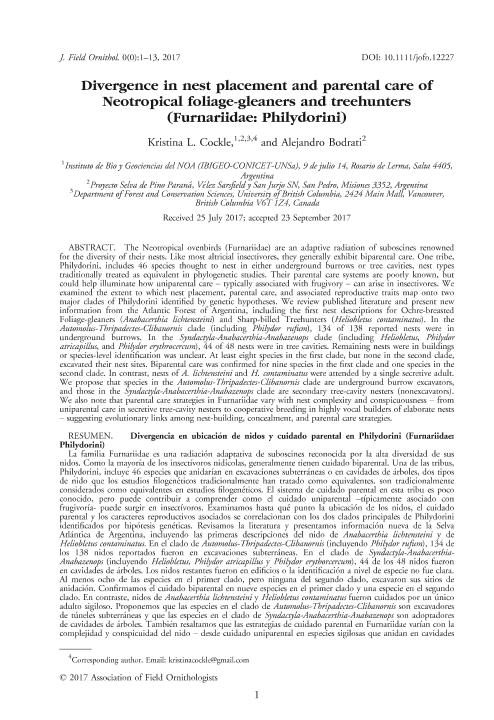Artículo
Divergence in nest placement and parental care of Neotropical foliage-gleaners and treehunters (Furnariidae: Philydorini)
Título:
Divergencia en ubicacion de nidos y cuidado parental en Philydorini (Furnariidae:Philydorini)
Fecha de publicación:
06/12/2017
Editorial:
Wiley Blackwell Publishing, Inc
Revista:
Journal Of Field Ornithology
ISSN:
0273-8570
Idioma:
Inglés
Tipo de recurso:
Artículo publicado
Clasificación temática:
Resumen
The Neotropical ovenbirds (Furnariidae) are an adaptive radiation of suboscines renowned for the diversity of their nests. Like most altricial insectivores, they generally exhibit biparental care. One tribe, Philydorini, includes 46 species thought to nest in either underground burrows or tree cavities, nest types traditionally treated as equivalent in phylogenetic studies. Their parental care systems are poorly known, but could help illuminate how uniparental care – typically associated with frugivory – can arise in insectivores. We examined the extent to which nest placement, parental care, and associated reproductive traits map onto two major clades of Philydorini identified by genetic hypotheses. We review published literature and present new information from the Atlantic Forest of Argentina, including the first nest descriptions for Ochre-breasted Foliage-gleaners (Anabacerthia lichtensteini) and Sharp-billed Treehunters (Heliobletus contaminatus). In the Automolus-Thripadectes-Clibanornis clade (including Philydor rufum), 134 of 138 reported nests were in underground burrows. In the Syndactyla-Anabacerthia-Anabazenops clade (including Heliobletus, Philydor atricapillus, and Philydor erythrocercum), 44 of 48 nests were in tree cavities. Remaining nests were in buildings or species-level identification was unclear. At least eight species in the first clade, but none in the second clade, excavated their nest sites. Biparental care was confirmed for nine species in the first clade and one species in the second clade. In contrast, nests of A. lichtensteini and H. contaminatus were attended by a single secretive adult. We propose that species in the Automolus-Thripadectes-Clibanornis clade are underground burrow excavators, and those in the Syndactyla-Anabacerthia-Anabazenops clade are secondary tree-cavity nesters (nonexcavators). We also note that parental care strategies in Furnariidae vary with nest complexity and conspicuousness – from uniparental care in secretive tree-cavity nesters to cooperative breeding in highly vocal builders of elaborate nests – suggesting evolutionary links among nest-building, concealment, and parental care strategies.
Archivos asociados
Licencia
Identificadores
Colecciones
Articulos(IBIGEO)
Articulos de INST.DE BIO Y GEOCIENCIAS DEL NOA
Articulos de INST.DE BIO Y GEOCIENCIAS DEL NOA
Citación
Cockle, Kristina Louise; Bodrati, Alejandro; Divergence in nest placement and parental care of Neotropical foliage-gleaners and treehunters (Furnariidae: Philydorini); Wiley Blackwell Publishing, Inc; Journal Of Field Ornithology; 88; 4; 6-12-2017; 336-348
Compartir
Altmétricas




